TORONTO, ON / ACCESSWIRE / April 7, 2021 / Talisker Resources Ltd. ("Talisker" or the "Company") (TSX:TSK)(OTCQX:TSKFF) is pleased to announce complete and partial drill assay results from its ongoing Stage One 50,000m drill program at the Bralorne Gold Project in British Columbia (Figure 1). Results have been received from the King Block (SB-2020-29), the Bralorne West Block (SB-2021-003A, SB-2021-004, SB-2021-005 and SB-2021-006) and the Bralorne East Block (SB-2021-001).
Key Points:
- Drilling continues to demonstrate excellent gold grade and structural continuity.
- Hole SB-2021-029 intersected previously unknown high-grade gold mineralisation ~750 metres below and along strike of the historic King Mine.
- Talisker currently has four drill rigs on site and has completed 18,111 metres of its current 50,000 metre drill program.
- A total of 4,965 samples are awaiting assay at the lab.
Today's results comprise assay results from the bottom half of hole SB-2020-29, the first hole drilled by Talisker in the King Block. Significantly, this hole demonstrates the potential for high-grade gold mineralisation below and along strike of the historic King Mine (Figure 2). From the Bralorne West Block, the bottom half of hole SB-2021-002, partial assay results from holes SB-2021-004, SB-2021-005 and SB-2021-006 and the complete set of assay results for hole SB-2021-003A were received. Also received were the bottom half of SB-2021-001 from the Bralorne East Block. All holes returned significant high-grade gold mineralisation further demonstrating the structural continuity of gold-bearing quartz veins along strike of the historic underground mines at the Bralorne Gold Project and will be incorporated into the dataset that will be used to define a resource estimate expected in 2022.
King Block
The first hole drilled by Talisker at the King Block suggests significant potential for high-grade gold mineralisation. Following on from the 5.09 g/t gold over 8.40m intersected in the top half of hole SB-2020-029 at King (press release March 16, 2021), the bottom half of the hole intersected high-grade gold mineralisation over 750m beyond the historic underground mine at King (Figure 2, Figure 3a and Table 1). More drilling is required to determine the continuity of these high-grade intersections.
Highlights from the King Block include:
- SB-2020-029
- 9.95 g/t gold over 0.90m from 827.90m to 828.80m
Bralorne East Block
Hole SB-2021-001 was the first hole drilled to the east of the Empire fault and was designed to target near-surface gold mineralisation within the Bralorne East Block, and today's results represent the second half of the hole following the release of the first half in the Company's press release of March 16, 2021. High-grade gold mineralisation intersected at 514m downhole is ~300m from the nearest high-grade intersection (Figure 2, Figure 3b and Table 1), further expanding high-grade gold mineralisation to the southeast.
Highlights from the Bralorne East Block include:
- SB-2021-001
- 13.90 g/t gold over 0.50m from 514.75m to 515.25m
- 12.85 g/t gold over 0.50m from 1,120.35m to 1,120.85m
Bralorne West Block
Drilling continues to demonstrate structural continuity along strike of the historic underground mine within the Bralorne West Block (Figure 2, Figure 3c and Table 1).
Highlights from the Bralorne West Block include:
- SB-2021-003A
- 10.30 g/t gold over 0.70m from 537.80m to 538.50m
- SB-2021-004
- 15.10 g/t gold over 1.00m from 380.70m to 381.70m
- SB-2021-005
- 16.55 g/t gold over 0.60m from 407.05m to 407.65m
- SB-2021-006
- 15.85 g/t gold over 0.60m from 556.60m to 557.20m
"Together with the consistency of the received gold grades, these results show significant down plunge extensions of the high-grade vein potential, particularly below the historic King Mine which was only mined to 350m from surface," commented Terry Harbort, President and CEO of Talisker, who added, "With each stepout hole we are seeing the dimensions of the system increasing from our initial view and we plan to increase our drill program to accommodate the new target areas."
Drill Hole Data
SB-2020-029 - King Block
- Complete preliminary assay results have been received for this hole.
- Talisker's first hole drilled proximal to the historic King Mine.
- Previously released: The C Vein was intersected at 322.30m and produced an intercept of 8.42 g/t Au over 5.00m, including high values of 37.4 g/t Au over 0.50m from 323.10m, and 31.60 g/t Au over 0.50m from 326.80m depth.
- The King Vein was intersected at 548.00m and produced an intercept of 4.49 g/t Au over 2.00m, including 6.12 g/t Au over 1.00m from 548.00m.
- An Unknown Vein was intersected at 755.95m and produced an intercept of 5.37 g/t Au over 0.80m.
- The BK Vein was intersected at 827.40m and produced an intercept of 6.71 g/t Au over 1.40m, including 9.95 g/t Au over 0.90m from 827.90m.
- The Alhambra Vein was intersected at 935.90m and produced an intercept of 8.07 g/t Au over 0.60m.
- This hole was suspended between December 14, 2020 and January 8, 2021 during a holiday break. SB-2020-029 was drilled to a final depth of 1,217.40m on February 18, 2021.
SB-2021-001 - Bralorne East Block
- Complete preliminary assay results have been received for this hole.
- Previously released: Unknown Vein produced 82.00 g/t Au over 0.50m from 171.40m depth.
- The 77 Vein was intersected at 513.00m and produced an intercept of 4.98 g/t Au over 2.75m, including 13.90 g/t Au over 0.50m from 514.75m.
- An Unknown Vein was intersected at 566.50m and produced an intercept of 4.46 g/t Au over 1.60m.
- The 222 Vein was intersected at 1118.95m and produced an intercept of 5.24 g/t Au over 1.90m, including 12.85 g/t Au over 0.50m from 1120.35m.
- This hole drilled to a final depth of 1,178.40m on February 3, 2021.
SB-2020-003A - Bralorne West Block
- Complete preliminary assay results have been received for this hole.
- The 55 Vein was intersected at 497.60m and produced an intercept of 2.98 g/t Au over 1.45m.
- The 55FW Vein was intersected at 537.30m and produced an intercept of 6.31 g/t Au over 1.20m, including 10.30 g/t Au over 0.70m from 537.80m.
- The 53 Vein was intersected at 693.75m and produced an intercept of 6.01 g/t Au over 2.90m, including 7.64 g/t Au over 1.40m from 694.25m.
- This hole drilled to a final depth of 865.80m on February 4, 2021.
SB-2021-004 - Bralorne West Block
- Partial preliminary assay results have been received for this hole.
- The Knight Zone was intersected at 380.70m and produced an intercept of 15.10 g/t Au over 1.00m.
- This hole drilled to a final depth of 683.00m on January 31, 2021.
SB-2021-005 - Bralorne West Block
- Partial preliminary assay results have been received for this hole.
- The Knight Zone was intersected at 407.05m and produced an intercept of 6.25 g/t Au over 1.70m, including 16.55 g/t Au over 0.60m from 407.05m.
- This hole drilled to a final depth of 853.60m on February 18, 2021.
SB-2021-006 - Bralorne West Block
- Partial preliminary assay results have been received for this hole.
- The Empire Zone was intersected at 310.60m and produced an intercept of 10.05 g/t Au over 0.65m.
- The 59 Vein was intersected at 556.00m and produced an intercept of 8.00 g/t Au over 1.20m, including 15.85 g/t Au over 0.60m from 556.60m.
- This hole drilled to a final depth of 628.60m on February 14, 2021.
|
Bralorne Gold Project |
|||||||||||
|
Diamond Drill |
From |
To |
Interval |
Au |
Zone |
Method |
|||||
|
SB-2020-029 |
548.00 |
549.00 |
1.00 |
6.12 |
King Vein |
Au-SCR24 |
|||||
|
SB-2020-029 |
549.00 |
549.50 |
0.50 |
1.44 |
Au-SCR24 |
||||||
|
SB-2020-029 |
549.50 |
550.00 |
0.50 |
4.29 |
Au-SCR24 |
||||||
|
SB-2020-029 |
755.95 |
756.75 |
0.80 |
5.37 |
Unknown Vein |
Au-AA24 |
|||||
|
SB-2020-029 |
827.40 |
827.90 |
0.50 |
0.87 |
BK Vein |
Au-AA24 |
|||||
|
SB-2020-029 |
827.90 |
828.80 |
0.90 |
9.95 |
Au-SCR24 |
||||||
|
SB-2020-029 |
935.90 |
936.50 |
0.60 |
8.07 |
Alhambra Vein |
Au-AA24 |
|||||
|
SB-2021-001 |
513.00 |
513.50 |
0.50 |
4.36 |
77 Vein |
Au-SCR24 |
|||||
|
SB-2021-001 |
513.50 |
514.20 |
0.70 |
1.57 |
Au-SCR24 |
||||||
|
SB-2021-001 |
514.20 |
514.75 |
0.55 |
3.34 |
Au-SCR24 |
||||||
|
SB-2021-001 |
514.75 |
515.25 |
0.50 |
13.90 |
Au-GRA22 |
||||||
|
SB-2021-001 |
515.25 |
515.75 |
0.50 |
3.27 |
Au-SCR24 |
||||||
|
SB-2021-001 |
566.50 |
567.10 |
0.60 |
6.40 |
Unknown Vein |
Au-AA24 |
|||||
|
SB-2021-001 |
567.10 |
567.60 |
0.50 |
4.38 |
Au-AA24 |
||||||
|
SB-2021-001 |
567.60 |
568.10 |
0.50 |
2.22 |
Au-AA24 |
||||||
|
SB-2021-001 |
1118.95 |
1119.85 |
0.90 |
0.66 |
222 Vein |
Au-AA24 |
|||||
|
SB-2021-001 |
1119.85 |
1120.35 |
0.50 |
5.88 |
Au-AA24 |
||||||
|
SB-2021-001 |
1120.35 |
1120.85 |
0.50 |
12.85 |
Au-GRA22 |
||||||
|
SB-2021-003A |
497.60 |
498.30 |
0.70 |
1.09 |
55 Vein |
Au-AA24 |
|||||
|
SB-2021-003A |
498.30 |
499.05 |
0.75 |
4.74 |
Au-AA24 |
||||||
|
SB-2021-003A |
537.30 |
537.80 |
0.50 |
0.72 |
55 FW Vein |
Au-AA24 |
|||||
|
SB-2021-003A |
537.80 |
538.50 |
0.70 |
10.30 |
Au-GRA22 |
||||||
|
SB-2021-003A |
693.75 |
694.25 |
0.50 |
2.36 |
53 Vein |
Au-SCR24 |
|||||
|
SB-2021-003A |
694.25 |
694.75 |
0.50 |
6.06 |
Au-SCR24 |
||||||
|
SB-2021-003A |
694.75 |
695.65 |
0.90 |
8.51 |
Au-SCR24 |
||||||
|
SB-2021-003A |
695.65 |
696.15 |
0.50 |
5.85 |
Au-SCR24 |
||||||
|
SB-2021-003A |
696.15 |
696.65 |
0.50 |
5.29 |
Au-SCR24 |
||||||
|
SB-2021-004 |
380.70 |
381.70 |
1.00 |
15.10 |
Knight Zone |
Au-SCR24 |
|||||
|
SB-2021-005 |
407.05 |
407.65 |
0.60 |
16.55 |
Knight Zone |
Au-GRA22 |
|||||
|
SB-2021-006 |
310.60 |
311.25 |
0.65 |
10.05 |
Empire |
Au-GRA22 |
|||||
|
SB-2021-006 |
556.60 |
557.20 |
0.60 |
15.85 |
59 Vein |
Au-SCR24 |
|||||
|
SB-2021-001 |
1118.95 |
1119.85 |
0.90 |
0.66 |
222 Vein |
||||||
Notes: Diamond drill hole SB-2020-029 has collar orientation of Azimuth 135; Dip -45. Diamond drill hole SB-2021-001 has collar orientation of Azimuth 121; Dip -69. Diamond drill hole SB-2021-003A has collar orientation of Azimuth 194; Dip -59. SB-2021-004 has collar orientation of Azimuth 127; Dip -62. SB-2021-005 has collar orientation of Azimuth 135; Dip -48. SB-2021-006 has collar orientation of Azimuth 120; Dip -45. True widths are estimated 40 - 90% of intercept lengths and are based on oriented core measurements where available. Method reported includes the most up to date information as of this press release.
Talisker is providing an opportunity for shareholders and other interested parties to participate in a Webinar to be held at 4 pm ET on Thursday, April 8th. To register, please click on the following link - https://us02web.zoom.us/webinar/register/WN_SbNtMIJvTey9WYbOnhNUyw. After registering, you will receive a confirmation email containing information about joining the webinar.
About Talisker Resources Ltd.
Talisker (taliskerresources.com) is a junior resource company involved in the exploration of gold projects in British Columbia, Canada. Talisker's projects include the Bralorne Gold Complex, an advanced stage project with significant exploration potential from a historical high-grade producing gold mine as well as its Spences Bridge Project where the Company holds ~85% of the emerging Spences Bridge Gold Belt and several other early-stage Greenfields projects. With its properties comprising 282,403 hectares over 258 claims, three leases and 198 crown grant claims, Talisker is a dominant exploration player in the south-central British Columbia. The Company is well funded to advance its aggressive systematic exploration program at its projects.
For further information, please contact:
|
Terry Harbort |
Mick Carew |
Qualified Person
The technical information contained in this news release relating to the drill results at the Bralorne Gold Project has been approved by Leonardo de Souza (BSc, AusIMM (CP) Membership 224827), Talisker's Vice President, Exploration and Resource Development, who is a "qualified person" within the meaning of National Instrument 43-101, Standards of Disclosure for Mineral Projects.
Sample Preparation and QAQC
Drill core at the Bralorne project is drilled in HQ to NQ size ranges (63.5mm and 47.6mm respectively). Drill core samples are minimum 50 cm and maximum 160 cm long along the core axis. Samples are focused on an interval of interest such as a vein or zone of mineralisation. Shoulder samples bracket the interval of interest such that a total sampled core length of not less than 3m both above and below the interval of interest must be assigned. Sample QAQC measures of unmarked certified reference materials (CRMs), blanks, and duplicates are inserted into the sample sequence and make up 9% of the samples submitted to the lab for holes reported in this release.
Sample preparation and analyses is carried out by ALS Global, at their laboratory in North Vancouver, British Columbia, Canada. Drill core sample preparation includes drying in an oven at a maximum temperature of 60°C, fine crushing of the sample to at least 70% passing less than 2 mm, sample splitting using a riffle splitter, and pulverizing a 250 g split to at least 85% passing 75 microns (code PREP-31).
Gold and in diamond drill core is analysed by fire assay and atomic absorption spectroscopy (AAS) of a 50g sample (code Au-AA24), while multi-element chemistry is analysed by 4-Acid digestion of a 0.25 g sample split with detection by inductively coupled plasma mass spectrometer (ICP-MS) for 48 elements (Ag, Al, As, Ba, Be, Bi, Ca, Cd, Ce, Co, Cr, Cs, Cu, Fe, Ga, Ge, Hf, In, K, La, Li, Mg, Mn, Mo, Na, Nb, Ni, P, Pb, Rb, Re, S, Sb, Sc, Se, Sn, Sr, Ta, Te, Th, Ti, Tl, U, V, W, Y, Zn, Zr).
Gold assay technique Au-AA24 has an upper detection limit of 10ppm. Any sample that produces an over-limit gold value via the Au-AA24 technique is sent for gravimetric finish via method Au-GRA22 which has an upper detection limit of 1,000 ppm Au. Samples where visible gold was observed are sent directly to screen metallics analysis and all samples that fire assay above 3 ppm Au are re-analysed with method Au-SCR24 which employs a 1kg pulp screened to 100 microns with assay of the entire oversize fraction and duplicate 50g assays on the undersize fraction. Where possible all samples initially sent to screen metallics processing will also be re-run through the fire assay with gravimetric finish provided there is enough material left for further processing.
Caution Regarding Forward Looking Statements
Certain statements contained in this press release constitute forward-looking information. These statements relate to future events or future performance. The use of any of the words "could", "intend", "expect", "believe", "will", "projected", "estimated" and similar expressions and statements relating to matters that are not historical facts are intended to identify forward-looking information and are based on Talisker's current belief or assumptions as to the outcome and timing of such future events. Actual future results may differ materially. In particular, this release contains forward-looking information relating to, among other things, the operations of the Company and the timing which could be affected by the current global COVID-19 pandemic. Those assumptions and factors are based on information currently available to Talisker. Although such statements are based on reasonable assumptions of Talisker's management, there can be no assurance that any conclusions or forecasts will prove to be accurate.
While Talisker considers these assumptions to be reasonable based on information currently available, they may prove to be incorrect. Forward looking information involves known and unknown risks, uncertainties and other factors which may cause the actual results, performance or achievements to be materially different from any future results, performance or achievements expressed or implied by the forward-looking information. Such factors include risks inherent in the exploration and development of mineral deposits, including risks relating to changes in project parameters as plans continue to be redefined, risks relating to variations in grade or recovery rates, risks relating to changes in mineral prices and the worldwide demand for and supply of minerals, risks related to increased competition and current global financial conditions and the COVID-19 pandemic, access and supply risks, reliance on key personnel, operational risks, and regulatory risks, including risks relating to the acquisition of the necessary licenses and permits, financing, capitalization and liquidity risks.
The forward-looking information contained in this release is made as of the date hereof, and Talisker is not obligated to update or revise any forward-looking information, whether as a result of new information, future events or otherwise, except as required by applicable securities laws. Because of the risks, uncertainties and assumptions contained herein, investors should not place undue reliance on forward-looking information. The foregoing statements expressly qualify any forward-looking information contained herein.
Figure 1: Map showing seven zones that comprise the Bralorne Gold Project, drill holes included in this press release, major gold-bearing quartz veins (white) and associated bounding structures, surface infrastructure and details of Talisker's current 50,000 metre resource drilling program.
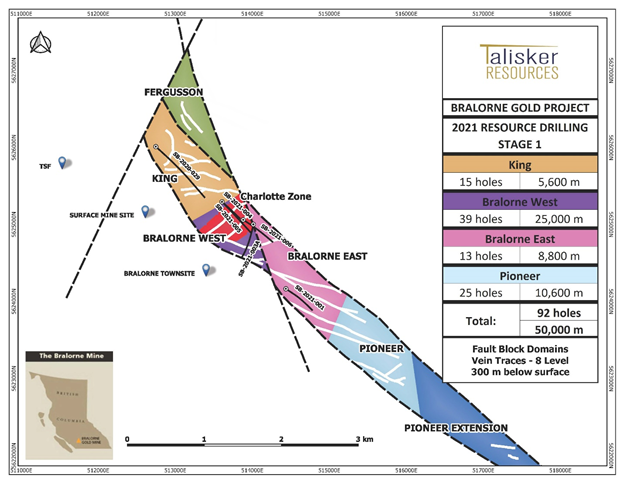
Figure 2: Long-section through the Bralorne deposit (refer to figure 1 for reference) showing the relative target depths for both the near-surface bulk tonnage gold mineralisation and the high-grade veins below, and drilling completed by Talisker with drill intercepts (in red) and highlight intersections.
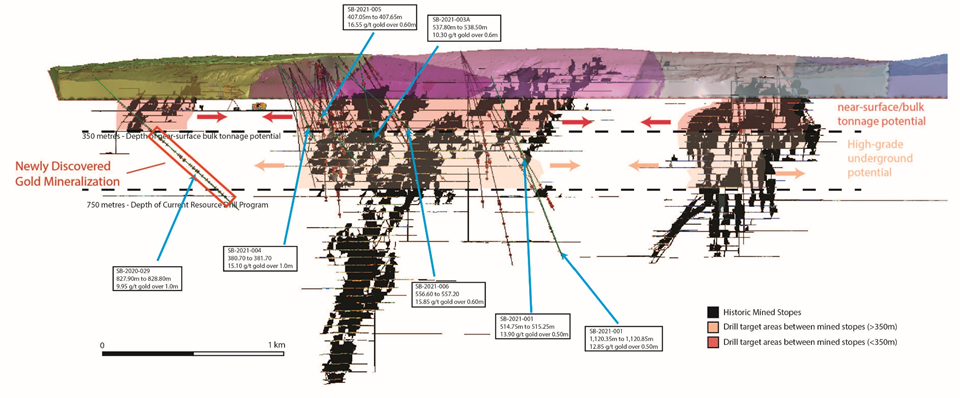
Figures 3a, 3b and 3c: Maps showing highlighted drill intersections from Bralorne East, Bralorne West and King (see Figure 1 for reference) - a) Hole SB-2021-001 drilled within Bralorne East; b) Hole SB-2020-029 drilled within King; and c) Holes SB-2021-003A, SB-2021-004, SB-2021-005 and SB-2021-006 drilled within Bralorne West.
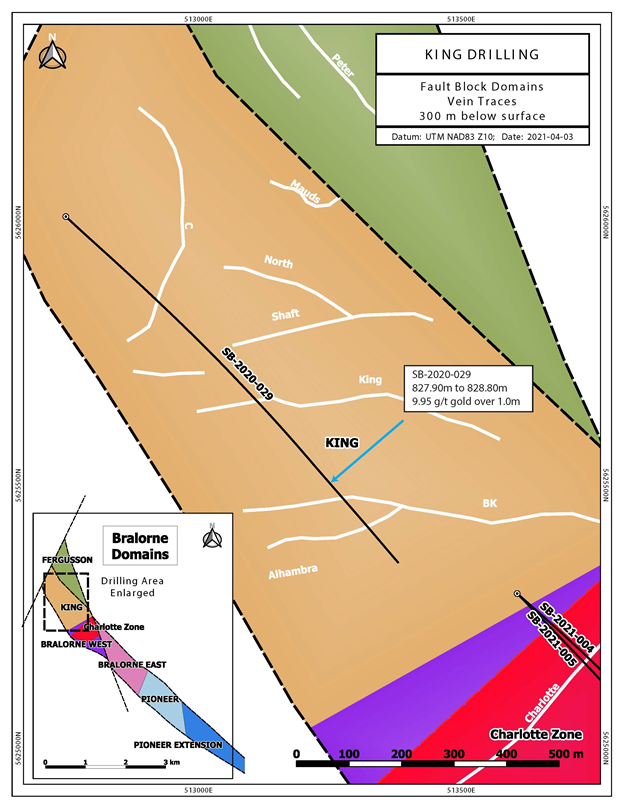
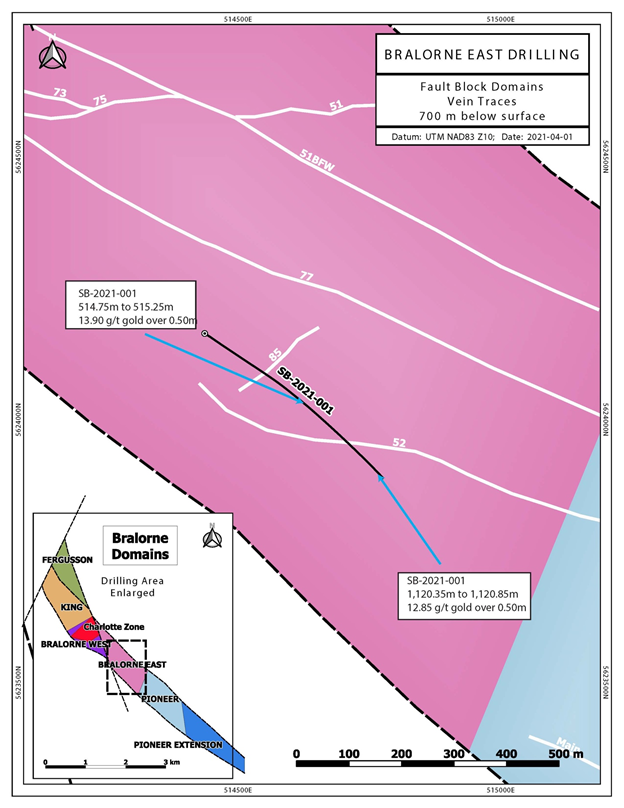
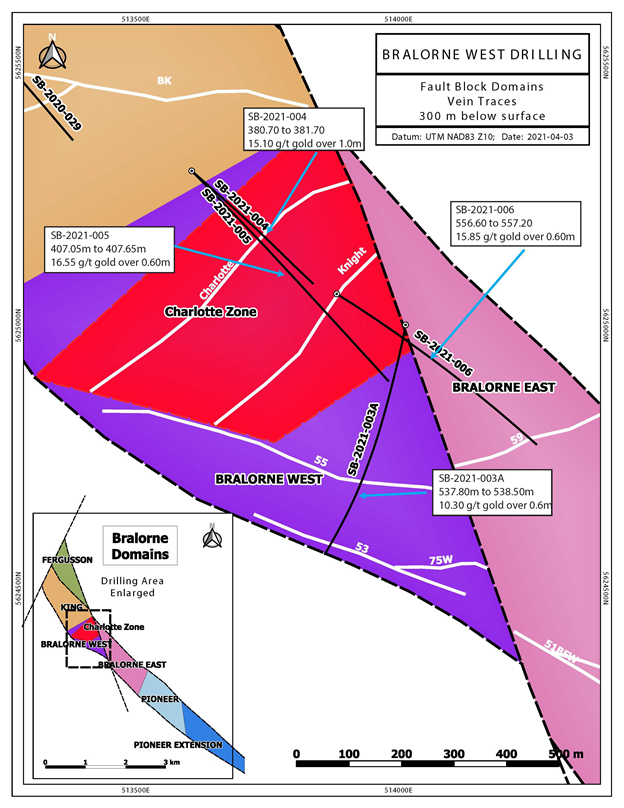
SOURCE: Talisker Resources Ltd.




